Yisi Sang
ODKE+: Ontology-Guided Open-Domain Knowledge Extraction with LLMs
Sep 04, 2025



Abstract:Knowledge graphs (KGs) are foundational to many AI applications, but maintaining their freshness and completeness remains costly. We present ODKE+, a production-grade system that automatically extracts and ingests millions of open-domain facts from web sources with high precision. ODKE+ combines modular components into a scalable pipeline: (1) the Extraction Initiator detects missing or stale facts, (2) the Evidence Retriever collects supporting documents, (3) hybrid Knowledge Extractors apply both pattern-based rules and ontology-guided prompting for large language models (LLMs), (4) a lightweight Grounder validates extracted facts using a second LLM, and (5) the Corroborator ranks and normalizes candidate facts for ingestion. ODKE+ dynamically generates ontology snippets tailored to each entity type to align extractions with schema constraints, enabling scalable, type-consistent fact extraction across 195 predicates. The system supports batch and streaming modes, processing over 9 million Wikipedia pages and ingesting 19 million high-confidence facts with 98.8% precision. ODKE+ significantly improves coverage over traditional methods, achieving up to 48% overlap with third-party KGs and reducing update lag by 50 days on average. Our deployment demonstrates that LLM-based extraction, grounded in ontological structure and verification workflows, can deliver trustworthiness, production-scale knowledge ingestion with broad real-world applicability. A recording of the system demonstration is included with the submission and is also available at https://youtu.be/UcnE3_GsTWs.
ConvKGYarn: Spinning Configurable and Scalable Conversational Knowledge Graph QA datasets with Large Language Models
Aug 12, 2024



Abstract:The rapid advancement of Large Language Models (LLMs) and conversational assistants necessitates dynamic, scalable, and configurable conversational datasets for training and evaluation. These datasets must accommodate diverse user interaction modes, including text and voice, each presenting unique modeling challenges. Knowledge Graphs (KGs), with their structured and evolving nature, offer an ideal foundation for current and precise knowledge. Although human-curated KG-based conversational datasets exist, they struggle to keep pace with the rapidly changing user information needs. We present ConvKGYarn, a scalable method for generating up-to-date and configurable conversational KGQA datasets. Qualitative psychometric analyses confirm our method can generate high-quality datasets rivaling a popular conversational KGQA dataset while offering it at scale and covering a wide range of human-interaction configurations. We showcase its utility by testing LLMs on diverse conversations - exploring model behavior on conversational KGQA sets with different configurations grounded in the same KG fact set. Our results highlight the ability of ConvKGYarn to improve KGQA foundations and evaluate parametric knowledge of LLMs, thus offering a robust solution to the constantly evolving landscape of conversational assistants.
APE: Active Learning-based Tooling for Finding Informative Few-shot Examples for LLM-based Entity Matching
Jul 29, 2024
Abstract:Prompt engineering is an iterative procedure often requiring extensive manual effort to formulate suitable instructions for effectively directing large language models (LLMs) in specific tasks. Incorporating few-shot examples is a vital and effective approach to providing LLMs with precise instructions, leading to improved LLM performance. Nonetheless, identifying the most informative demonstrations for LLMs is labor-intensive, frequently entailing sifting through an extensive search space. In this demonstration, we showcase a human-in-the-loop tool called APE (Active Prompt Engineering) designed for refining prompts through active learning. Drawing inspiration from active learning, APE iteratively selects the most ambiguous examples for human feedback, which will be transformed into few-shot examples within the prompt. The demo recording can be found with the submission or be viewed at https://youtu.be/OwQ6MQx53-Y.
FLEEK: Factual Error Detection and Correction with Evidence Retrieved from External Knowledge
Oct 26, 2023



Abstract:Detecting factual errors in textual information, whether generated by large language models (LLM) or curated by humans, is crucial for making informed decisions. LLMs' inability to attribute their claims to external knowledge and their tendency to hallucinate makes it difficult to rely on their responses. Humans, too, are prone to factual errors in their writing. Since manual detection and correction of factual errors is labor-intensive, developing an automatic approach can greatly reduce human effort. We present FLEEK, a prototype tool that automatically extracts factual claims from text, gathers evidence from external knowledge sources, evaluates the factuality of each claim, and suggests revisions for identified errors using the collected evidence. Initial empirical evaluation on fact error detection (77-85\% F1) shows the potential of FLEEK. A video demo of FLEEK can be found at https://youtu.be/NapJFUlkPdQ.
Few-Shot Character Understanding in Movies as an Assessment to Meta-Learning of Theory-of-Mind
Nov 09, 2022Abstract:When reading a story, humans can rapidly understand new fictional characters with a few observations, mainly by drawing analogy to fictional and real people they met before in their lives. This reflects the few-shot and meta-learning essence of humans' inference of characters' mental states, i.e., humans' theory-of-mind (ToM), which is largely ignored in existing research. We fill this gap with a novel NLP benchmark, TOM-IN-AMC, the first assessment of models' ability of meta-learning of ToM in a realistic narrative understanding scenario. Our benchmark consists of $\sim$1,000 parsed movie scripts for this purpose, each corresponding to a few-shot character understanding task; and requires models to mimic humans' ability of fast digesting characters with a few starting scenes in a new movie. Our human study verified that humans can solve our problem by inferring characters' mental states based on their previously seen movies; while the state-of-the-art metric-learning and meta-learning approaches adapted to our task lags 30% behind.
GEMv2: Multilingual NLG Benchmarking in a Single Line of Code
Jun 24, 2022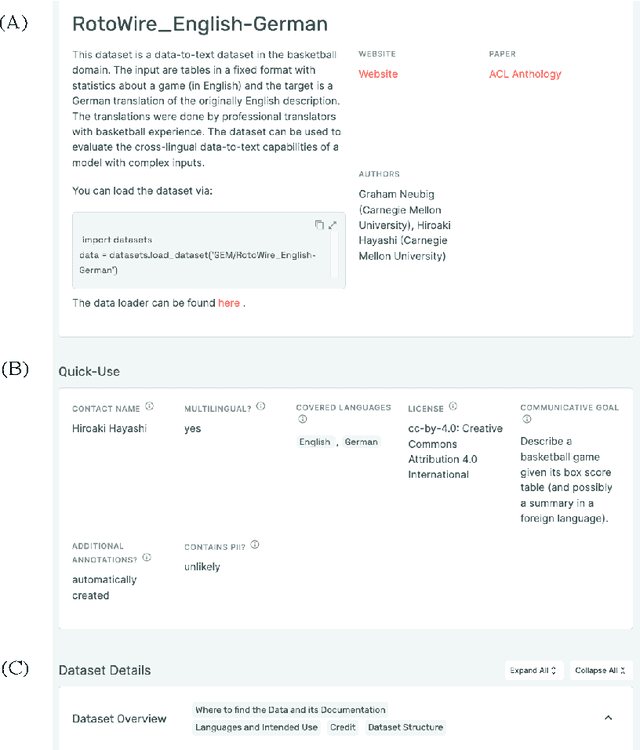
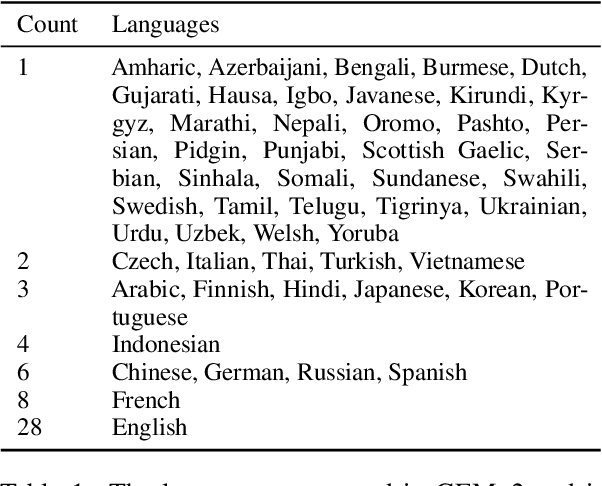
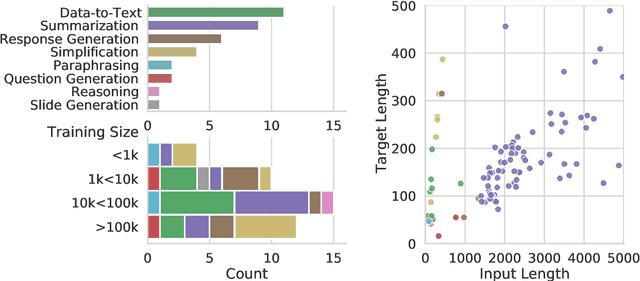
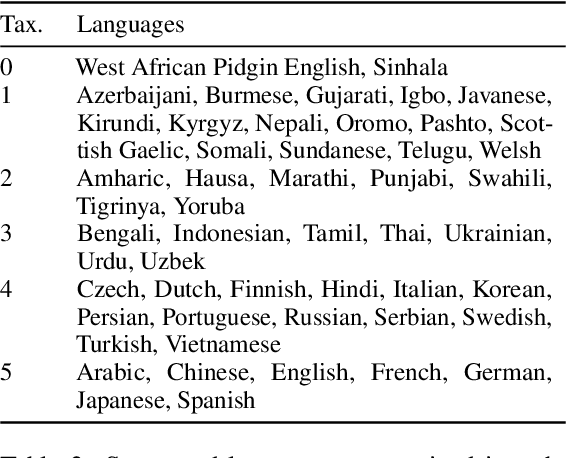
Abstract:Evaluation in machine learning is usually informed by past choices, for example which datasets or metrics to use. This standardization enables the comparison on equal footing using leaderboards, but the evaluation choices become sub-optimal as better alternatives arise. This problem is especially pertinent in natural language generation which requires ever-improving suites of datasets, metrics, and human evaluation to make definitive claims. To make following best model evaluation practices easier, we introduce GEMv2. The new version of the Generation, Evaluation, and Metrics Benchmark introduces a modular infrastructure for dataset, model, and metric developers to benefit from each others work. GEMv2 supports 40 documented datasets in 51 languages. Models for all datasets can be evaluated online and our interactive data card creation and rendering tools make it easier to add new datasets to the living benchmark.
A Survey of Machine Narrative Reading Comprehension Assessments
Apr 30, 2022
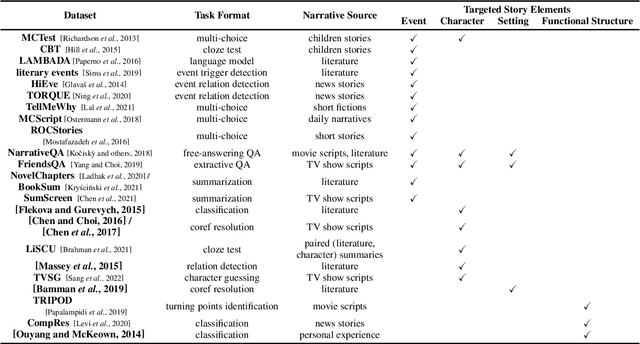
Abstract:As the body of research on machine narrative comprehension grows, there is a critical need for consideration of performance assessment strategies as well as the depth and scope of different benchmark tasks. Based on narrative theories, reading comprehension theories, as well as existing machine narrative reading comprehension tasks and datasets, we propose a typology that captures the main similarities and differences among assessment tasks; and discuss the implications of our typology for new task design and the challenges of narrative reading comprehension.
TVShowGuess: Character Comprehension in Stories as Speaker Guessing
Apr 16, 2022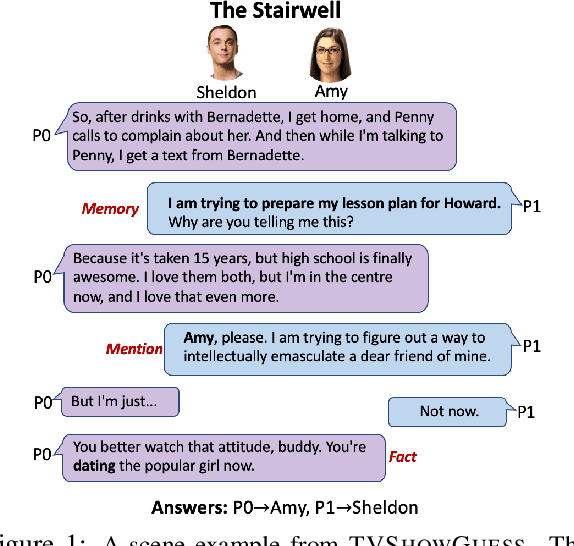


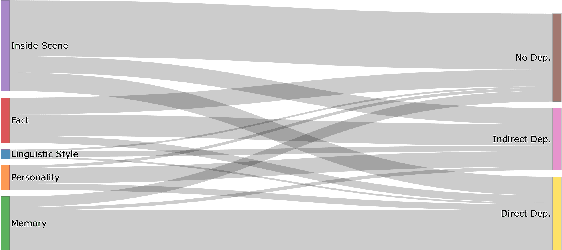
Abstract:We propose a new task for assessing machines' skills of understanding fictional characters in narrative stories. The task, TVShowGuess, builds on the scripts of TV series and takes the form of guessing the anonymous main characters based on the backgrounds of the scenes and the dialogues. Our human study supports that this form of task covers comprehension of multiple types of character persona, including understanding characters' personalities, facts and memories of personal experience, which are well aligned with the psychological and literary theories about the theory of mind (ToM) of human beings on understanding fictional characters during reading. We further propose new model architectures to support the contextualized encoding of long scene texts. Experiments show that our proposed approaches significantly outperform baselines, yet still largely lag behind the (nearly perfect) human performance. Our work serves as a first step toward the goal of narrative character comprehension.
Fantastic Questions and Where to Find Them: FairytaleQA -- An Authentic Dataset for Narrative Comprehension
Mar 26, 2022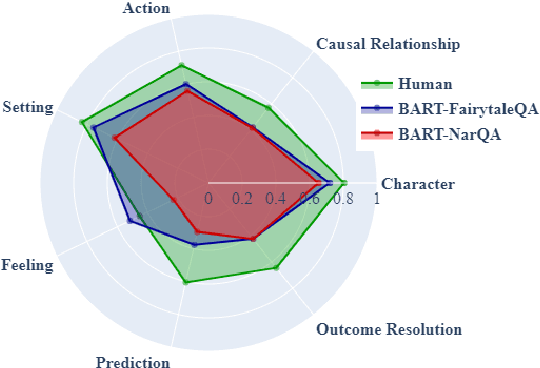

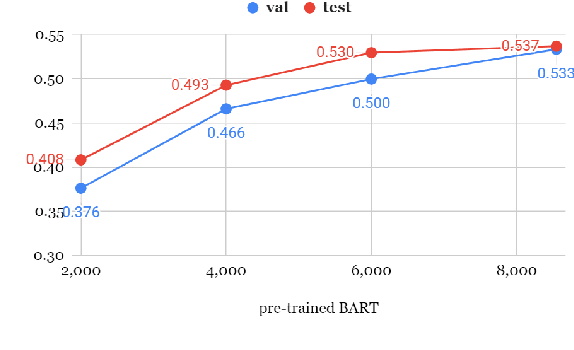

Abstract:Question answering (QA) is a fundamental means to facilitate assessment and training of narrative comprehension skills for both machines and young children, yet there is scarcity of high-quality QA datasets carefully designed to serve this purpose. In particular, existing datasets rarely distinguish fine-grained reading skills, such as the understanding of varying narrative elements. Drawing on the reading education research, we introduce FairytaleQA, a dataset focusing on narrative comprehension of kindergarten to eighth-grade students. Generated by educational experts based on an evidence-based theoretical framework, FairytaleQA consists of 10,580 explicit and implicit questions derived from 278 children-friendly stories, covering seven types of narrative elements or relations. Our dataset is valuable in two folds: First, we ran existing QA models on our dataset and confirmed that this annotation helps assess models' fine-grained learning skills. Second, the dataset supports question generation (QG) task in the education domain. Through benchmarking with QG models, we show that the QG model trained on FairytaleQA is capable of asking high-quality and more diverse questions.
 Add to Chrome
Add to Chrome Add to Firefox
Add to Firefox Add to Edge
Add to Edge